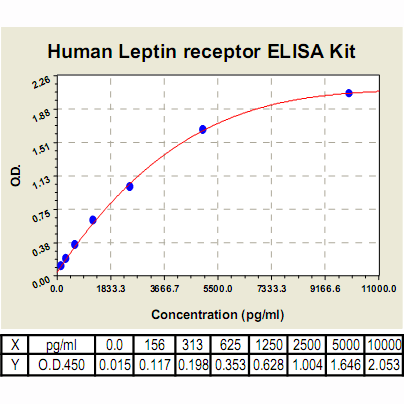Product Sheet CL0439
Description
BACKGROUND Leptin, the 16-kDa protein product of the ob gene, is an adipocyte-derived hormone that influences energy homeostasis through effects on energy intake and expenditure, the secretion and action of metabolic hormones, and neuroendocrine function. Leptin acts through receptors that bear strong sequence homology to the class I cytokine receptor family. Mutations in the leptin receptor gene occur in db/db mice, and fa/fa and Koletsky rats, producing severe obesity with resistance to endogenous and exogenous leptin. At least five isoforms of the leptin receptor are generated by alternative mRNA splicing, but signaling is thought to occur through the “long isoform” (OBRl). OBRl is predicted to have a long intracellular domain of 302 amino acid residues. Three short forms (OBRs) have predicted cytoplasmic domains ranging from 32 to 40 amino acids. These four isoforms have identical extracellular and transmembrane domains. Furthermore, the membrane-proximal 29 amino acids are also identical. The additional 273, 3, 5, and 11 cytoplasmic residues, respectively, are generated by alternative splicing and are encoded by separate exons. Furthermore, a soluble receptor with no transmembrane region has also been predicted. OBRs is highly expressed in kidney, lungs, and choroid plexus, while OBRl is most abundant in the hypothalamus, but may be expressed at lower levels elsewhere.1
Leptin binding to the extracellular domain of the LRb dimer activates the Jak2 tyrosine kinase that associates with OBRl via the Box 1 motif and intracellular amino acids 31–36 of LRb. Activated Jak2 tyrosine phosphorylates itself and Tyr985 and Tyr1138 on the intracellular tail of OBRl. Phosphorylated Tyr1138 binds and mediates the phosphorylation-dependent activation of signal transducer and activator of transcription 3 (STAT3), which activates transcription of suppressor of cytokine signaling 3 (SOCS3) (a feedback inhibitor of OBRl signaling) and pro-opiomelanocortin (POMC) (an anorexigenic neuropeptide) and inhibits the transcription of agouti-related protein (AgRP) (an orexigenic neuropeptide). Phosphorylated Tyr985 recruits the SH2-containing tyrosine phosphatase SHP-2, which is itself phosphorylated and binds growth factor receptor binding 2 (Grb-2) to activate the signaling pathway that culminates in extracellular signal-regulated kinase (ERK) activation. During prolonged stimulation, after induction of SOCS3 protein, phosphorylated Tyr985 also mediates binding of SOCS3. Signals mediated via unidentified tyrosine phosphorylation sites on OBRl include the tyrosine phosphorylation of insulin receptor substrate (IRS) proteins and a minor component of ERK activation.2 It has been shown that that both OBRs and OBRl had the ability to activate JAK2 and IRS-1 tyrosine phosphorylation in a leptin-dependent manner in transiently transfected cell lines. Both isoforms were also able to induce leptin-dependent activation of MAPK in both transiently transfected cells and in stable CHO cell lines. It is clear that OBRl more robustly activate these pathways than does OBRs. In contrast, only the long form of the leptin receptor had the ability to activate STAT3 tyrosine phosphorylation and to stimulated c-fos gene transcription.3
Leptin binding to the extracellular domain of the LRb dimer activates the Jak2 tyrosine kinase that associates with OBRl via the Box 1 motif and intracellular amino acids 31–36 of LRb. Activated Jak2 tyrosine phosphorylates itself and Tyr985 and Tyr1138 on the intracellular tail of OBRl. Phosphorylated Tyr1138 binds and mediates the phosphorylation-dependent activation of signal transducer and activator of transcription 3 (STAT3), which activates transcription of suppressor of cytokine signaling 3 (SOCS3) (a feedback inhibitor of OBRl signaling) and pro-opiomelanocortin (POMC) (an anorexigenic neuropeptide) and inhibits the transcription of agouti-related protein (AgRP) (an orexigenic neuropeptide). Phosphorylated Tyr985 recruits the SH2-containing tyrosine phosphatase SHP-2, which is itself phosphorylated and binds growth factor receptor binding 2 (Grb-2) to activate the signaling pathway that culminates in extracellular signal-regulated kinase (ERK) activation. During prolonged stimulation, after induction of SOCS3 protein, phosphorylated Tyr985 also mediates binding of SOCS3. Signals mediated via unidentified tyrosine phosphorylation sites on OBRl include the tyrosine phosphorylation of insulin receptor substrate (IRS) proteins and a minor component of ERK activation.2 It has been shown that that both OBRs and OBRl had the ability to activate JAK2 and IRS-1 tyrosine phosphorylation in a leptin-dependent manner in transiently transfected cell lines. Both isoforms were also able to induce leptin-dependent activation of MAPK in both transiently transfected cells and in stable CHO cell lines. It is clear that OBRl more robustly activate these pathways than does OBRs. In contrast, only the long form of the leptin receptor had the ability to activate STAT3 tyrosine phosphorylation and to stimulated c-fos gene transcription.3
REFERENCES
1. Münzberg, H. et al: Cell. Mol. Life. Sci. 62: 642-52,2005
2. Bates, S.H. & Myers, M.G. Jr.: Trends Endocrinol Metab. 14:447-52, 2003
3. Myers, M.G. Jr.: Recent Prog. Horm. Res. 59:287-304, 2004
2. Bates, S.H. & Myers, M.G. Jr.: Trends Endocrinol Metab. 14:447-52, 2003
3. Myers, M.G. Jr.: Recent Prog. Horm. Res. 59:287-304, 2004
Products are for research use only. They are not intended for human, animal, or diagnostic applications.
Details
Cat.No.: | CL0439 |
Target Protein Species: | Human |
Range: | 156pg/ml – 10000pg/ml |
Specificity: | No detectable cross-reactivity with any other cytokine |
Storage: | Store at 4°C. Use within 6 months. |
ELISA Kits are based on standard sandwich enzyme-linked immunosorbent assay technology. Freshly prepared standards, samples, and solutions are recommended for best results.

